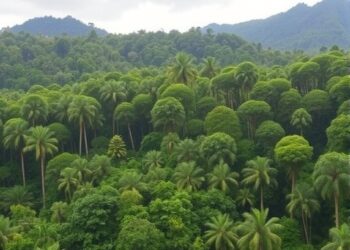The transition from the African Humid Period (AHP) to dry conditions in North Africa is the clearest example of climate tipping points in recent geological history. They occur when small perturbations trigger a large, non-linear response in the system and shift the climate to a different future state, usually with dramatic consequences for the biosphere. That was also the case in North Africa, where the grasslands, forests, and lakes favored by humans disappeared, causing them to retreat to areas like the mountains, oases, and the Nile Delta. This development is of particular relevance for researchers, not least because it is an impressive example of how quickly and extensively climate change can affect human societies.
The transition from the African Humid Period (AHP) to dry conditions in North Africa is the clearest example of climate tipping points in recent geological history. They occur when small perturbations trigger a large, non-linear response in the system and shift the climate to a different future state, usually with dramatic consequences for the biosphere. That was also the case in North Africa, where the grasslands, forests, and lakes favored by humans disappeared, causing them to retreat to areas like the mountains, oases, and the Nile Delta. This development is of particular relevance for researchers, not least because it is an impressive example of how quickly and extensively climate change can affect human societies.
Climate researchers have identified two main types of tipping points: With the first type, processes slow at an increasing rate and the climate has a hard time recovering from disturbances until a transition occurs. The second type is characterized by a flickering between stable humid and dry climates that occurs shortly before the transition. “The two types of tipping points differ with regard to the early warning signals that can be used to recognize them,” explains Martin Trauth. “Researching and better understanding them is important if we want to be able to predict possible future climate tipping points caused by humans. While the slowdown seen in the first type of tipping point leads to a decrease in variability, autocorrelation, and skewness, the flickering in the second type leads to the exact opposite – and, in some cases, to the impending tipping point not being recognized.”
In the large-scale project, led by Martin Trauth together with colleagues from the Universities of Cologne, Aberystwyth, and Addis Ababa and funded, among others, by the German Research Foundation (DFG), researchers are analyzing lake sediments obtained by means of scientific deep drilling in the Chew Bahir Basin, a former freshwater lake in eastern Africa. “For the current study, six shorter (9 to 17 meters) and two long (292 meters) drill cores were evaluated, which can be used to reconstruct the past 620,000 years of climate history in the region,” explains Dr. Verena Förster-Indenhuck from the University of Cologne.
“At the end of the AHP, we observed at least 14 dry events in the short cores from Chew Bahir, each of which lasted 20-80 years and recurred at intervals of 160±40 years,” says Trauth. “Later in the transitional phase, starting in 6,000 BC, seven wet events occurred in addition to the dry events, which were of a similar duration and frequency. These high-frequency, extreme wet-dry events represent a pronounced ‘climate flickering’ that can be simulated in climate models and can also be observed in earlier climate transitions in the environmental records from Chew Bahir. This indicates that transitions with flickering are characteristic of this region.”
The fact that very similar transitions can also be found in the older sections of the sediment cores also supports this. In particular, the changeover from humid to dry climate around 379,000 years ago looks like a perfect copy of the transition at the end of the African Humid Period. “This is interesting because this transition was natural, so to speak, as it occurred at a time when human influence on the environment was negligible,” says co-author Prof. Stefanie Kaboth-Bahr of Freie Universität Berlin. Thus, there are many arguments against human activity leading to an accelerated end of the AHP, as proposed by American colleagues. Conversely, people in the region where undoubtedly affected by the climate tipping: The traces of settlement in the Nile valley at the end of the African Humid Period attract millions of tourists to the region every year.
The study on the web:
Martin H. Trauth, Asfawossen Asrat, Markus L. Fischer, Peter O. Hopcroft, Verena Foerster, Stefanie Kaboth-Bahr, Karin Kindermann, Henry F. Lamb, Norbert Marwan, Mark A. Maslin, Frank Schaebitz, Paul J. Valdes, 2024, Early warning signals of the termination of the African Humid Period(s), Nature Communications, DOI:
Images:
Drill site 2A_credit_Verena_Foerster: Scientific deep drilling in Chew Bahir, southern Ethiopia. Photo: Dr. Verena Förster-Indenhuck
Ethiopia_ChewBahir_2014_Dust Storm_credit_Verena_Foerster: Dust storm on the surface of the remote Chew Bahir Basin, a salt pan in southern Ethiopia, near the drill site of the Chew Bahir records spanning 620,000 years. Photo: Dr. Verena Förster-Indenhuck
Contact: Martin H. Trauth, Professor of Paleoclimate Dynamics
E-Mail: martin.trauth@uni-potsdam.de
Phone: +49 331 977-5810
Media information 07-05-2024/ No. 032
Matthias Zimmermann
University of Potsdam
Press and Public Relations Department
Am Neuen Palais 10
14469 Potsdam
Phone: +49 331 977-1474
Fax: +49 331 977-1130
E-Mail: presse@uni-potsdam.de
Internet: www.uni-potsdam.de/en/presse
Journal
Nature Communications




